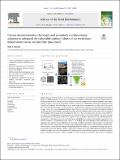| dc.contributor.author | Rowan, Neil J. | |
| dc.date.accessioned | 2023-03-02T15:46:09Z | |
| dc.date.available | 2023-03-02T15:46:09Z | |
| dc.date.copyright | 2024 | |
| dc.date.issued | 2023-02-24 | |
| dc.identifier.citation | Rowan, Neil J . (2023). Current decontamination challenges and potentially complementary solutions to safeguard the vulnerable seafood industry from recalcitrant human norovirus in live shellfish: Quo Vadis?. Science of the Total Environment. 874: 162380. DOI: 10.1016/j.scitotenv.2023.162380 | en_US |
| dc.identifier.issn | 0048-9697 | |
| dc.identifier.uri | https://research.thea.ie/handle/20.500.12065/4405 | |
| dc.description.abstract | Safeguarding the seafood industry is important given its contribution to supporting our growing global population.
However, shellfish are filter feeders that bioaccumulate microbial contaminants in their tissue from wastewater
discharged into the same coastal growing environments leading to significant human disease outbreaks unless appro priately mitigated. Removal or inactivation of enteric viruses is very challenging particularly as human norovirus
(hNoV) binds to specific histo-blood ligands in live oyster tissue that are consumed raw or lightly cooked. The regula tory framework that sets out use of clean seawater and UV disinfection is appropriate for bacterial decontamination at
the post-harvest land-based depuration (cleaning) stage. However, additional non-thermal technologies are required
to eliminate hNoV in live shellfish (particularly oysters) where published genomic studies report that low-pressure
UV has limited effectiveness in inactivating hNoV. The use of the standard genomic detection method (ISO 15,
216–1:2017) is not appropriate for assessing the loss of infectious hNoV in treated live shellfish. The use of surrogate
viral infectivity methods appear to offer some insight into the loss of hNoV infectiousness in live shellfish during de contamination. This paper reviews the use of existing and potentially other combinational treatment approaches to en hance the removal or inactivation of enteric viruses in live shellfish. The use of alternative and complementary novel
diagnostic approaches to discern viable hNoV are discussed. The effectiveness and virological safety of new affordable
hNoV intervention(s) require testing and validating at commercial shellfish production in conjunction with laboratory-based research. Appropriate risk management planning should encompass key stakeholders including local govern ment and the wastewater industry. Gaining a mechanistic understanding of the relationship between hNoV response
at molecular and structural levels in individually treated oysters as a unit will inform predictive modeling and appropriate treatment technologies. Global warming of coastal growing environments may introduce a contaminant challenges (such as invasive species); thus, underscoring need to develop real-time ecosystem monitoring
of growing environments to alert shellfish producers to appropriately mitigate these threats. | en_US |
| dc.format | PDF | en_US |
| dc.language.iso | eng | en_US |
| dc.publisher | Elsevier | en_US |
| dc.relation.ispartof | Science of the Total Environment | en_US |
| dc.rights | Attribution-NonCommercial-NoDerivs 3.0 United States | * |
| dc.rights.uri | http://creativecommons.org/licenses/by-nc-nd/3.0/us/ | * |
| dc.subject | Norovirus | en_US |
| dc.subject | Food security | en_US |
| dc.subject | Sustainability | en_US |
| dc.subject | Decontamination | en_US |
| dc.subject | Shellfish | en_US |
| dc.subject | Diagnostics | en_US |
| dc.title | Current decontamination challenges and potentially complementary solutions to safeguard the vulnerable seafood industry from recalcitrant human norovirus in live shellfish: Quo Vadis? | en_US |
| dc.type | info:eu-repo/semantics/article | en_US |
| dc.contributor.affiliation | Technological University of the Shannon: Midlands Midwest | en_US |
| dc.contributor.sponsor | MSCA RISE ICHTHYS Project [No. 872217] and Interreg Atlantic Area NEPTUNUS Pro ject [No. EAPA_576/2018] | en_US |
| dc.description.peerreview | yes | en_US |
| dc.identifier.doi | 10.1016/j.scitotenv.2023.162380 | en_US |
| dc.identifier.orcid | https://orcid.org/0000-0003-1228-3733 | en_US |
| dc.identifier.volume | 874 | en_US |
| dc.rights.accessrights | info:eu-repo/semantics/openAccess | en_US |
| dc.subject.department | Bioscience Research Institute TUS:MM | en_US |
| dc.type.version | info:eu-repo/semantics/publishedVersion | en_US |


